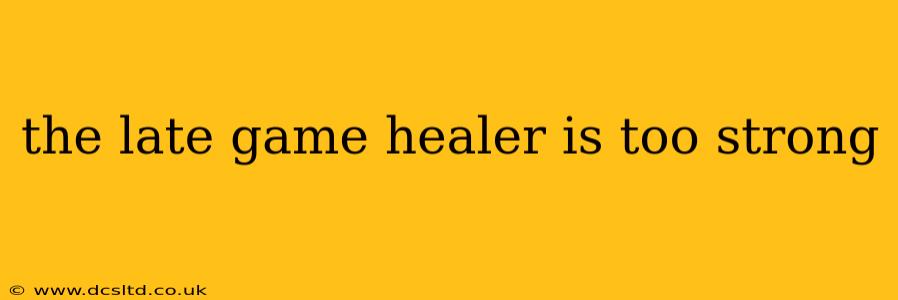The Late-Game Healer Problem: Are Support Champions Overpowered?
The late-game dominance of certain healer champions is a recurring topic of discussion in many multiplayer online battle arena (MOBA) games. Players frequently express frustration with the perceived overwhelming power of these champions in the later stages of a match, leading to lopsided victories and frustrating gameplay experiences. This issue isn't about whether healing is a necessary game mechanic – it's about the balance between healing capabilities, other champion abilities, and overall game design. This article will delve into the complexities of this problem, examining the underlying causes and exploring potential solutions.
Why Are Late-Game Healers So Strong?
The power of late-game healers often stems from a combination of factors:
-
Scaling Abilities: Many healer champions have abilities that scale significantly with items and levels. This means their healing output increases dramatically as the game progresses, making them increasingly difficult to deal with. A small heal early game might become a game-changing burst of healing later.
-
Item Synergies: Certain items synergize exceptionally well with healer champions, further amplifying their healing potential and survivability. This creates a snowball effect – the more items they acquire, the more effective they become, potentially making them nearly unkillable.
-
Teamfight Impact: A highly effective healer can dramatically shift the momentum of a teamfight. Their ability to keep allies alive allows their team to sustain damage and pressure for far longer, leading to decisive victories. This makes focusing them a risky proposition, as the damage dealt might be offset by the immediate healing.
-
Lack of Counterplay: In some game designs, there might be a lack of effective counterplay to powerful late-game healers. This can leave players feeling helpless against teams with dominant healers, regardless of their own skill or strategy.
What Makes a Healer "Too Strong"?
The perception of a healer being "too strong" is subjective and depends on various factors:
-
Win Rate: Consistently high win rates for a specific healer champion across different skill levels often indicate an imbalance. However, win rate alone isn't a perfect metric.
-
Pick/Ban Rate: High pick/ban rates suggest that players consider the champion extremely impactful and often necessary for success. A high ban rate particularly points to a frustrating champion for opponents.
-
Player Perception: The feeling of helplessness or unfairness when facing a powerful late-game healer is crucial. Even if statistics don't show an imbalance, widespread negative player sentiment indicates a problem.
-
Game Design: The overall game design, including map layout, itemization, and champion synergy, can contribute to the effectiveness of late-game healers.
How Can We Address the Late-Game Healer Problem?
Addressing this problem requires a multifaceted approach:
-
Rebalancing Champions: Developers need to carefully rebalance healer champions, adjusting their scaling, ability cooldowns, and mana costs. This should focus on creating a more even playing field throughout the game, preventing extreme power spikes in the late game.
-
Item Adjustments: Items that synergize too well with healers might need adjustments to reduce their overall effectiveness. This could involve changing stats, adding drawbacks, or creating counter-items.
-
Champion Design: Designing new champions with inherent counterplay mechanisms against powerful healers can provide more strategic options for players.
-
Community Feedback: Regular communication with the community and actively considering player feedback is crucial for identifying and addressing balance issues.
What Are Some Examples of Late-Game Healers?
(This section would require specifics of the game in question. For example, in League of Legends, champions like Soraka or Janna are often cited as strong late-game healers.)
In conclusion, the perception of late-game healers being "too strong" is a complex issue stemming from multiple intertwined factors. Developers must strike a balance between providing effective healing and preventing overwhelming dominance. Addressing this requires a comprehensive strategy that includes champion rebalancing, item adjustments, new champion design, and continuous community engagement. Only through careful monitoring and iterative adjustments can a fair and enjoyable gameplay experience be maintained for all players.
